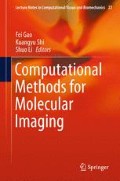Abstract
The recurrence of cancer increases the risk of death. The ability to predict such recurrence could be beneficial to planning treatment. We aim to find a predictive feature subset from a series of spatiotemporal PET image characteristics, including SUV-based and texture features, in order to predict lung tumor recurrence one year after treatment. To overcome the small sample size, class imbalance problem, we propose a hierarchical forward selection algorithm to select the smallest feature subset that results in the best prediction performance. As the SUV-based features have been recognized as significant predictive factors for a patient’s outcome, we propose incorporating this prior knowledge into the selection procedure to improve its robustness and accelerate its convergence. By fixing the first feature as one SUV parameter, the proposed hierarchical forward selection yields a small robust feature subset with promising prediction performance.
This work is partly supported by China Scholarship Council.
Access this chapter
Tax calculation will be finalised at checkout
Purchases are for personal use only
References
Canu, S., Grandvalet, Y., Guigue, V., Rakotomamonjy, A.: SVM and kernel methods Matlab toolbox. Perception Systèmes et Information, INSA de Rouen, Rouen, France (2005)
Chen, Xw, Wasikowski, M.: FAST: A roc-based feature selection metric for small samples and imbalanced data classification problems. In: ACM SIGKDD, KDD’08, pp. 124–132. ACM, New York (2008). doi:10.1145/1401890.1401910
El Naqa, I., Grigsby, P., Apte, A., Kidd, E., Donnelly, E., Khullar, D., Chaudhari, S., Yang, D., Schmitt, M., Laforest, R., et al.: Exploring feature-based approaches in pet images for predicting cancer treatment outcomes. Pattern Recognit. 42(6), 1162–1171 (2009)
Guyon, I., Elisseeff, A.: An introduction to variable and feature selection. JMLR 3, 1157–1182 (2003)
Guyon, I., Weston, J., Barnhill, S., Vapnik, V.: Gene selection for cancer classification using support vector machines. Mach. Learn. 46(1–3), 389–422 (2002)
He, H., Garcia, E.: Learning from imbalanced data. IEEE Trans. Knowl. Data Eng. 21(9), 1263–1284 (2009)
Mi, H., Petitjean, C., Dubray, B., Vera, P., Ruan, S.: Prediction of lung tumor evolution during radiotherapy in individual patients with PET. IEEE Trans. Med. Image 33(4), 995–1003 (2014)
Roman-Jimenez, G., Leseur, J., Devillers, A., David, J.: Segmentation and characterization of tumors in 18F-FDG PET-CT for outcome prediction in cervical cancer radio-chemotherapy. Image-Guidance and Multimodal Dose Planning in Radiation Therapy, p. 17 (2012)
Somol, P., Novovicova, J.: Evaluating stability and comparing output of feature selectors that optimize feature subset cardinality. IEEE Trans. Pattern Anal. Mach. Intell. 32(11), 1921–1939 (2010)
Tan, S., Kligerman, S., Chen, W., Lu, M., Kim, G., Feigenberg, S., D’Souza, W.D., Suntharalingam, M., Lu, W.: Spatial-temporal [18F] FDG-PET features for predicting pathologic response of esophageal cancer to neoadjuvant chemoradiation therapy. Int. J. Radiat. Oncol.* Biol.* Phys. 85(5), 1375–1382 (2013)
Tixier, F., Hatt, M., Le Rest, C.C., Le Pogam, A., Corcos, L., Visvikis, D.: Reproducibility of tumor uptake heterogeneity characterization through textural feature analysis in 18F-FDG PET. J. Nucl. Med. 53(5), 693–700 (2012)
Wang, L.: Feature selection with kernel class separability. IEEE Trans. Pattern Anal. Mach. Intell. 30(9), 1534–1546 (2008)
Yang, F., Mao, K.: Robust feature selection for microarray data based on multicriterion fusion. IEEE/ACM TCBB 8(4), 1080–1092 (2011)
Author information
Authors and Affiliations
Corresponding author
Editor information
Editors and Affiliations
Rights and permissions
Copyright information
© 2015 Springer International Publishing Switzerland
About this chapter
Cite this chapter
Mi, H., Petitjean, C., Vera, P., Ruan, S. (2015). Robust Feature Selection to Predict Lung Tumor Recurrence. In: Gao, F., Shi, K., Li, S. (eds) Computational Methods for Molecular Imaging. Lecture Notes in Computational Vision and Biomechanics, vol 22. Springer, Cham. https://doi.org/10.1007/978-3-319-18431-9_11
Download citation
DOI: https://doi.org/10.1007/978-3-319-18431-9_11
Published:
Publisher Name: Springer, Cham
Print ISBN: 978-3-319-18430-2
Online ISBN: 978-3-319-18431-9
eBook Packages: EngineeringEngineering (R0)

